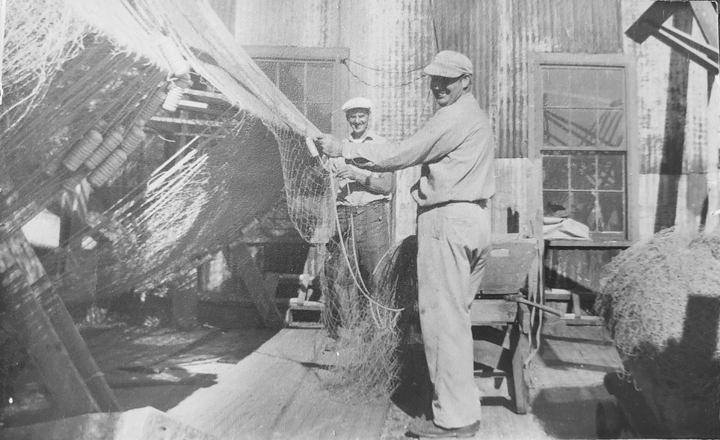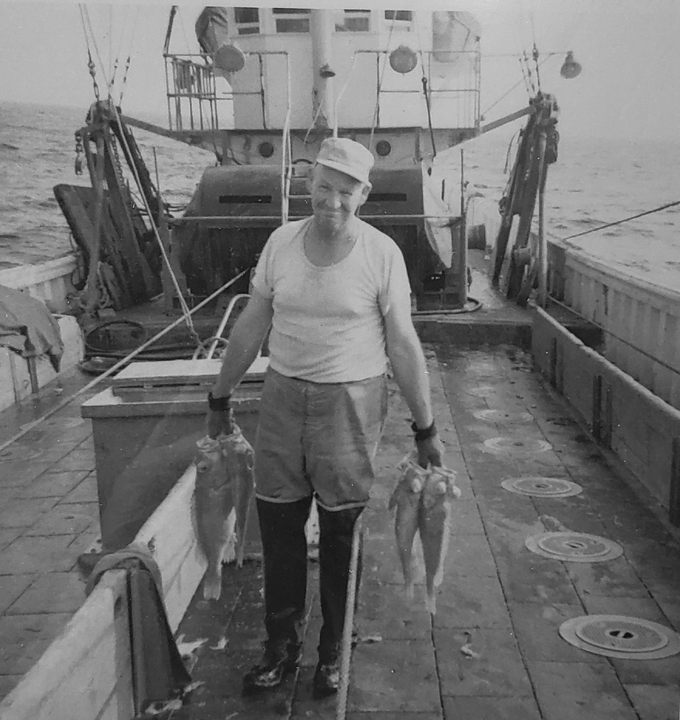

Albert Vincent “Suzie” Werner, Willis Spear’s father-in-law.
Part III
Willis Spear of Yarmouth has been discussing his fishing life on Casco Bay and the people who influenced him and some of the stories he remembers hearing from them. In this part he begins talking about his wife’s father Albert Vincent Werner, who fished his whole life. The photograph to the right is he and his brother reeling gill nets on what Willis thought was Holyoke, Long or Pocahontas Wharf in Portland. His nickname was Suzie and Willis explained, “The reason they called him Suzie is because he had a sister, Suzie, and they hung around together onMunjoy Hill. Wherever Big Suzie was he was, so they called him Little Suzie and it stuck the rest of his life.”
Albert fished on the 117-foot WAWENOCK, which was built at the Gamage yard in South Bristol in 1953. In one photo the deck is covered with red fish and Willis added, “Evidently they got them too fast. He said they used to like to try and catch them in a week. I know he fished with Dicky Friend out of Portland. There were three Friends, there was Dicky, Freddy, and Butch and two of them drowned. Dicky and Freddy had a 55-foot Bruno and they fishing together,Butchywasn’t with them. They were good fishermen with O’Hara. They dropped the doors at night somewhere outside of New Ledge and it got rough and they were taking water over the stern and the hatch to the lazerette was loose and the lazerette filled and they did not have a chance to get a call off or anything.Butchy got shot in a domestic dispute. He was a good guy, but when he got drinking he was a little different and when the cop came he attacked him.
“My father-in-law didn’t want to go on WAWENOCK,” continued Willis. “He had been gill netting and there was a guy by the name of Ozzy Howard who was the engineer, he used to come over and visit Suzie all the time. They lived over bythe University of Maine, and he would say they needed somebody, but he didn’t want to go. His mother made him go and he said it was the best boat he had ever been on. The deck platesyou put the fish down, well most deck plates are galvanized and those were bronze. He said the deck engine for the winch behind the house was an 871 with chrome valve covers and spotless. In this picture they are shoveling ice out of the holdbecause they are running out of pens to put the fish.So they are taking all the ice out of the pens and putting it on deck then they are going to run the fish down the middle of the boat they call the ‘slaughter’ to fill it. They are in the process of filling the boat, but they are towing in this picture because you can see the wires are out so they are going to get another set. My father-in-law said he didn’t like it that much because they had to pack them in like an overfilled suitcase. He was on there for seven years, they wound up lobstering out of Newport, Rhode Island in the end on the Continental Shelf with a boat and they didn’t like it so they gave it up eventually.”
Later on this boat was sold to someone from Gloucester. Willis added, “She was rammed by another boat off of Long Island, New York aft of the gallows frame and the other boat sunk, collapsed the stem. This thing was oak on oak and eventually they burned her some place out of Gloucester. There are pictures of her on-line. I have seen one of her out of Stonington, Connecticut. There was one picture, they called her the LITTLE AL, she was painted kind of a bluish color.”
“Bob Anderson from Rockland owned the boat and he was partners with another guy by the name of Maynard Labby,” added Willis. Maynard owned POCAHONTAS and he owned part of the WAWENOCK with Bob. Bob bought his share out eventually. They told me Maynard was a Finn. There was a population of Finns around Rockland, like that Kosti Ruohomaa that did the photographs. He just went out. Then there was Jimmy Farrell, the guy that smoked the cigar, the little stub cigar with the plastic mouth holder. He was about this tall, they called him a little giant. They made fun of his height and in his stateroom someone made a ladder to the toilet. They told me he was a tail gunner on a B17 because of his size. His brother was Neil Farrell that fishing out of Portland for a while but ran a boat up at Rockland, one of the red fish boats. Tommy Turner was on these boats and he lives in Brunswick. He was Bob Anderson’s son-in-law.
The WAWWENOCK was powered with a Wolverine, which weighed twice as much as the 398 they later put in. The new engine would do twice the amount of work.
A few other names that Willis mentioned were Bill Doughty, whose brother is part-owner of Washburn & Doughty of East Boothbay; Bob Crowe, who was from Bailey’s Island; Frankie Mallow from Portland; and Mike O’Reilly, from Cliff Island, who was the shore engineer and engineer on a boat owned by the Harris Company. “Bernard Harris was one of the three Harris Brothers that owned Harris Company,” said Willis. “He owned Harris Oil, and the boat VANDAL. VANDAL was run at this time by a guy named Boog Doughty, his real name was Reuben Doughty and he was from Long Island. They all liked to fish with him, he was just a real gentle man back in the days, back when the sound machines were kind of imperfect and the old Loran A were not too predictable. He caught fish and did it without a lot of fuss.”
“These guys taught me how to go dragging,” explained Willis. “My father-in-law built all my nets when I had that Newman built. I have four sons, Marshall, Colby, Jed, and another brother who passed away. They all went fishing. I made them go to see if they liked it or not. I remember we had a pile of traps on the boat at the community dock that we used. In the winter time nobody used it much so we were bringing gear up and getting ready to go dragging, spitting snow, cold, it was dark out maybe 5:30 or so, I told my wife to bring them all down, we will pick the traps off the boat, all they have to do is slide them up the rail. We had a piece of quarter round stainless on the handrail. I can remember those guys coming down in their pajamas with their boots on, heavy coats and I would set the trap up and they would push it up the dock. This will cure them, they will never want to go fishing again. Yeah, they all went, every one of them and they have done well.”
Looking at another photograph Willis pointed out that this was where DiMillo’s is now. He added, “There were two wharves there, Pocahontas and Long Wharf. Pocahontas got its name from the Pocahontas Coal Company. On the condominium side that caught fire and it burned down Pocahontas and Long wharves. Long Wharf was just that, the longest wharf in Portland out beyond Custom House and beyond Willard’s Wharf. There was a lot of gill netters, and a lot of them were Danes and Swedes that lived in Portland and a lot of them went fishing. I call them square heads. It is not a derogatory remark because someone once told me that when they were in Oslo, Norway they saw a sign that said, haircut, $4.00, a dollar a side, but it had to do with the nails. Scandinavians made their nails with square heads so that is why they called everybody from Scandinavia square heads. I learned that from a kid who was a Caterpillar mechanic in New York City and his last name was Abrahamsen. He was a Norwegian and he told me that story. Our son Marshall bought a fiberglass boat, a 35 T. Jason in Great South Bay on Long Island. It needed a little bit of work before we brought her home. I noticed on the front of the engine, the 3116 had a pulley system that ran a water pump and that belt needed to be tightened and we could not free up the idler. By a miracle of God, we got this mechanic, Abrahamsen, and he came down and put a torch. It had an aluminum cover on the front of the engine and he said, ‘you keep it on there, don’t take it off.’ We heated up that bolt and it finally let go enough to loosen up. He told me on 9-11, he was the first man to show up with the generators. He stayed there for two weeks and that was all he could take. He also told us, if you run into bad weather, you don’t have to go out through the entrance to Great South Bay, which was Fire Island, you could run inside Fire Island all the way to Shinnecook. I looked at a chart and said, no way. He said, you can do it. That day we went it was a miserable southeaster and we had to run on the inside thick fog, all the way to Shinnecook. There is a canal at Shinnecook that runs north in the Great Peconic Bay and once you cross the Great Peconic Bay you are up where Shelter Island is.
All Willis’ sons attended Maine Maritime Academy and two of them graduated from there. Willis said, “I have got an engineer’s license, small one for tugs and I had to renew it and the last two times I went to Castine. Inevitably if you travel in that circle you will run into somebody that you know. Both times I went up there, there was somebody that I knew. This last time was advanced firefighting and I am getting a little older and to go into a burning house with a Scott air pack is getting tougher. There was a kid that sailed with Chevron, he was a lawyer and didn’t like it and now sails first mate and is happy. He helped me get my Scott air pack on so it didn’t have the twists in it, so I got through alright.”
Willis’ father went to MMA, Class of 1944 and his wife’s brother also went, Class of 1968. “My first cousin,” added Willis, “He just passed away at 77. He went to sea until he was 72 on the DEEP WATER PATHFINDER, which was an exploratory drill ship the last of it.”
Willis earned his degree at Vocational School and went to sea after he got out on seismic ships for two or three years. But more about that in the next issue!



